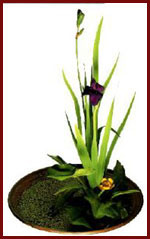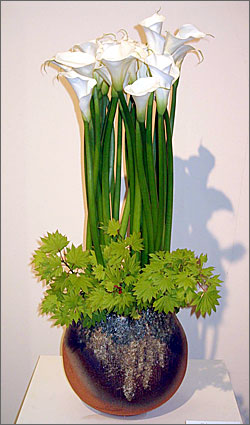In Focus
This section features the topic of the month
which covers general information & culture of Japan.

 Ikebana
is Japan's art of flower arrangement. While most Westerners
arranged their flowers symmetrically in a vase, Japanese
Ikebana is more complex. Western people have always emphasized
the quantity and colors of the materials concentrating
mainly to the beauty of blossoms. However, the Japanese
give emphasis to the line of the arrangement. They have
developed the art to include the stem, leaves and branches
as well as flowers. Ikebana
is Japan's art of flower arrangement. While most Westerners
arranged their flowers symmetrically in a vase, Japanese
Ikebana is more complex. Western people have always emphasized
the quantity and colors of the materials concentrating
mainly to the beauty of blossoms. However, the Japanese
give emphasis to the line of the arrangement. They have
developed the art to include the stem, leaves and branches
as well as flowers.
The underlying principles in Ikebana are indicated by
three main lines which are symbolic of Heaven, Man and
Earth. These form the framework upon which the whole structure
of Ikebana is built.
There are many schools of Ikebana. The most popular are
Ikenobo, Sogetsu and Ohara. There are also different styles
depending on the school and the plants and vase used.
Ikenobo is the oldest school founded in 15 th century
by Ikenobo Senkei, a Buddhist priest. He introduced the
rikka style (standing flowers) as a Buddhist expression
of the beauty of nature, with seven branches representing
hills, waterfalls, valleys arranged in a formal way. Among
the priests and aristocrats, the rikka styke became more
and more formal until in the 17 th century, the growing
merchant class developed a simpler style called shoka.
Unlike the rikka, shoka uses only three main branches
known as ten (heaven), chi (earth) and jin (man). It is
designed to show the beauty of the plant itself. Another
old form of Ikebana is nageire which is used in the tea
ceremony. The Ikenobo School is now on its 45 th year
with Ikenobo Senfei as the head.
 In
the late 19th century one of the members of the Ikenobo
School , Ohara Unshin, left the school to form the first
of the modern school, the Ohara School . The school generally
uses a formal style called moribana which means piled-up
flowers, in a shallow, flat container. The school started
at a time when Western culture was heavily influential
in Japan and the moribana style made good use of Western
plants. In
the late 19th century one of the members of the Ikenobo
School , Ohara Unshin, left the school to form the first
of the modern school, the Ohara School . The school generally
uses a formal style called moribana which means piled-up
flowers, in a shallow, flat container. The school started
at a time when Western culture was heavily influential
in Japan and the moribana style made good use of Western
plants.
However, because of the influence from the artistic movement
s of the early 20 th century, the jiyuka or free style
of arrangement was developed. Despite all the changes
in style, Ikebana was only for the nobility.
In the 1930s and during the postwar period, many people
became interested in Ikebana, Schools opened which attracted
people of all social classes. Teshigahara Sofu, founder
of the Sogetsu School introduced new materials such as
plastic, plaster and steel.
Today there are about 3,000 Ikebana schools in Japan
and thousands around the world.
|



 Ikebana
is Japan's art of flower arrangement. While most Westerners
arranged their flowers symmetrically in a vase, Japanese
Ikebana is more complex. Western people have always emphasized
the quantity and colors of the materials concentrating
mainly to the beauty of blossoms. However, the Japanese
give emphasis to the line of the arrangement. They have
developed the art to include the stem, leaves and branches
as well as flowers.
Ikebana
is Japan's art of flower arrangement. While most Westerners
arranged their flowers symmetrically in a vase, Japanese
Ikebana is more complex. Western people have always emphasized
the quantity and colors of the materials concentrating
mainly to the beauty of blossoms. However, the Japanese
give emphasis to the line of the arrangement. They have
developed the art to include the stem, leaves and branches
as well as flowers. In
the late 19th century one of the members of the Ikenobo
School , Ohara Unshin, left the school to form the first
of the modern school, the Ohara School . The school generally
uses a formal style called moribana which means piled-up
flowers, in a shallow, flat container. The school started
at a time when Western culture was heavily influential
in Japan and the moribana style made good use of Western
plants.
In
the late 19th century one of the members of the Ikenobo
School , Ohara Unshin, left the school to form the first
of the modern school, the Ohara School . The school generally
uses a formal style called moribana which means piled-up
flowers, in a shallow, flat container. The school started
at a time when Western culture was heavily influential
in Japan and the moribana style made good use of Western
plants.